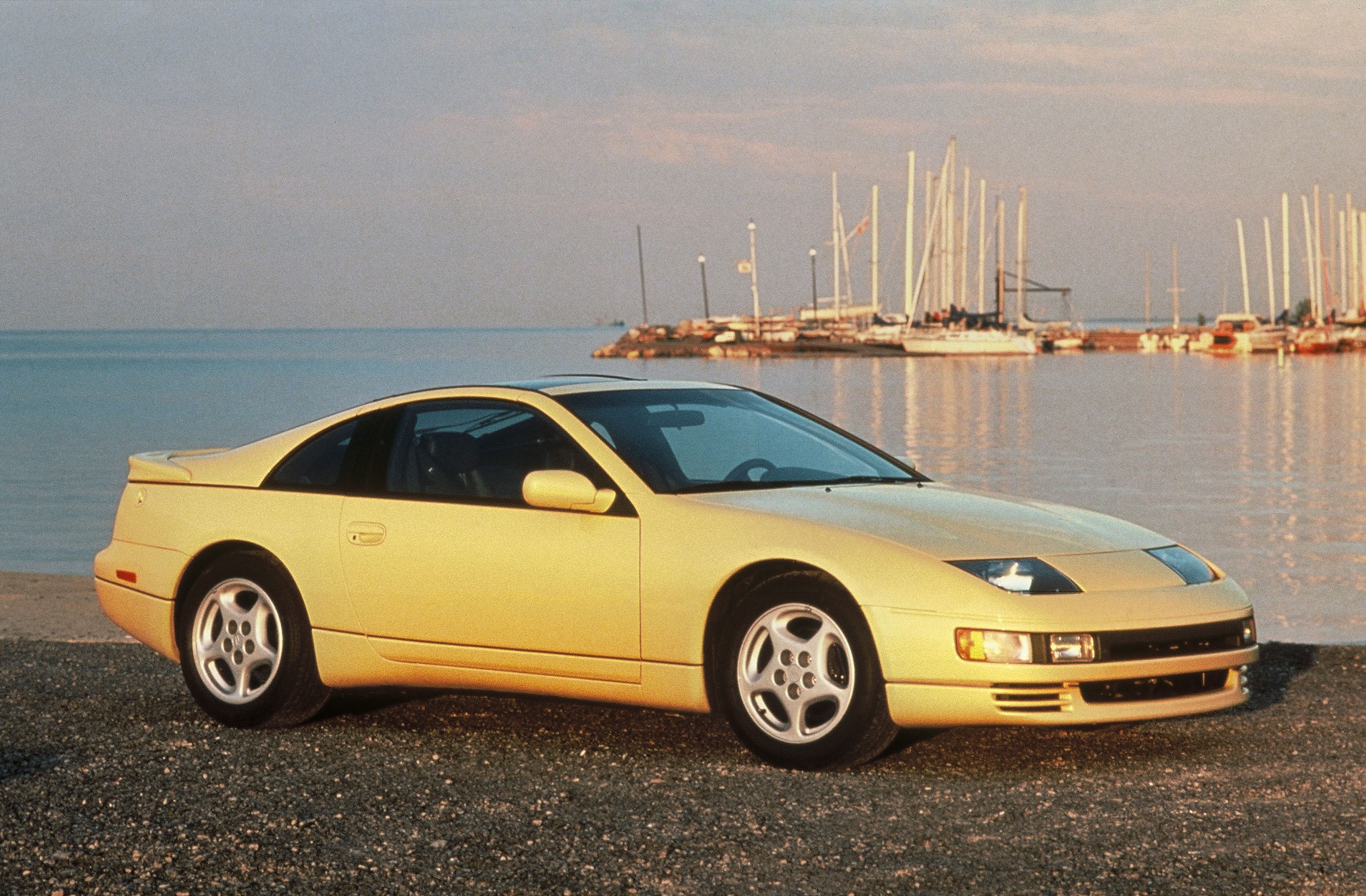The automotive landscape of the late 1980s and early 1990s witnessed a resurgence of Japanese sports cars, and at the forefront of this movement was the 1990 Nissan 300zx. Emerging as a stark departure from its predecessors, the Z32 generation 300ZX, debuting as a 1990 model, injected a potent dose of performance and sophisticated design back into the Z-car lineage. In an era defined by musical shifts from the raw energy of proto-punk to the burgeoning sounds of a new decade, the 1990 300ZX mirrored this evolution, embodying a refined yet exhilarating spirit that resonated with enthusiasts and critics alike. Where earlier Z cars had hinted at a drift towards heavier, more luxurious grand touring, the 1990 300ZX emphatically reversed course, re-establishing itself as a serious sports car contender ready to challenge European rivals.
Nissan’s Renaissance and the Arrival of the Z32
The late 1980s were a period of significant revitalization for Nissan. In 1989, the company presented a lineup that defied the more subdued image it had been cultivating. The Maxima sedan earned accolades as a legitimate “four-door sports car,” the 240SX became the darling of a new generation of car enthusiasts seeking an affordable and engaging rear-wheel-drive platform, and then, the 1990 Nissan 300ZX arrived.
Unveiled in the late summer of 1989 as a 1990 model, the Z32 300ZX immediately captured attention. Car and Driver magazine, known for its discerning automotive journalism, heralded it as “one of the most alluring cars to appear on the United States market in years.” This wasn’t hyperbole; the 1990 Nissan 300ZX has aged remarkably well. The design, penned by Isao Sono and Toshio Yamashita, possesses a timeless quality that transcends the typical aesthetic trends of the 1990s. Its enduring appeal is so strong that it arguably hinders its “classic car” perception – it simply doesn’t look dated. Even the 2+2 variant, often a design compromise in sports car aesthetics, was executed with exceptional visual harmony. Echoes of the Z32’s design language can even be seen in the contemporary Nissan Z, a testament to its lasting impact.
Body Styles and Engine Options
The 1990 Nissan 300ZX launched with two primary body styles: the sleek two-seater coupe and the elongated 2+2. Adding to the versatility, a factory-authorized convertible, crafted by American Sunroof Corporation (ASC), joined the lineup in 1993, marking the first time a Z-car offered a factory convertible option. The majority of Z32s were equipped with removable T-tops, offering an open-air driving experience. Slicktop coupes, devoid of T-tops and available from 1991 onwards, are considerably rarer and sought after by collectors.
Under the hood, the initial powerplant was a sophisticated 3.0-liter DOHC V6 engine featuring variable valve timing, producing a robust 222 horsepower. However, the performance pinnacle was reached with the twin-turbocharged version of the V6. This forced-induction marvel unleashed 300 horsepower (detuned to 280 hp when paired with an automatic transmission), a figure that was groundbreaking in 1989. To put this into perspective, even the vaunted Porsche 911 Turbo of that era didn’t surpass this output.
Beyond sheer horsepower, the 1990 Nissan 300ZX boasted advanced technology that elevated its performance and handling. The Twin Turbo model incorporated a highly advanced multi-link suspension system coupled with Super HICAS (High Capacity Actively Controlled Steering), a four-wheel steering system. Unlike passive rear-wheel steering systems, Super HICAS was a computer-aided, hydraulically actuated system that dynamically adjusted the rear wheels’ steering angle – either in the opposite phase or in phase with the front wheels – based on driver input and driving conditions. This sophisticated system significantly enhanced the car’s agility in cornering and stability at higher speeds, contributing to its reputation for exceptional handling.
Model Year Refinements (1990-1996)
The Nissan 300ZX saw several noteworthy updates throughout its production run for the North American market:
- 1990: Introduction year, featuring T-top coupe and 2+2 body styles. Initially launched with the naturally aspirated engine, the Twin Turbo variant became available later in the model year.
- 1991: The base coupe without T-tops (slicktop) was introduced. A Nissan badge was added to the front fascia.
- 1992: A driver’s side airbag became standard across all models. Interior door panels were upgraded to a faux-suede material. Power seats became standard on Turbo models.
- 1993: The convertible model debuted, featuring a roll-hoop and designed/produced by ASC. It was equipped with a manual soft top and reinforced chassis.
- 1994: Super HICAS transitioned from hydraulic to electronic actuation. A passenger airbag was added, and a new foam pedestal-style rear spoiler was introduced.
- 1995: The windshield washer fluid reservoir was relocated from the rear hatch area to under the hood. The lower portion of the front bumper was changed to body color from charcoal gray.
- 1996: OBD II port added. Variable valve timing was discontinued. Nissan released 300 “Commemorative Edition” 300ZXs to mark its departure from the North American market. Factors cited for its discontinuation included inability to meet US side-impact safety standards and unfavorable exchange rates making it increasingly expensive. Production continued for the Japanese Domestic Market until 2000.
What to Inspect When Considering a 1990 Nissan 300ZX
While earlier Z cars were prone to rust, the Z32 generation exhibited improved corrosion resistance. However, potential buyers should still be diligent in their inspections:
- Rust: While severe rust is less common, check for bubbling on rocker panels and door jambs. Leaking T-tops or hatch seals can lead to surface rust.
- Paint: Clearcoat failure, especially on metallic finishes, is a common issue.
- Accident Damage: Poor accident repairs are unfortunately frequent. A paint thickness meter can be a valuable tool. Misaligned front panels, hood, bumper, and headlights can indicate prior front-end damage due to the plastic clips used in assembly. Pre-1995 models with body-colored lower bumper sections are a sign of repaint, as they were originally charcoal gray.
- T-Tops: Most 300ZXs have T-tops, which can develop leaks as seals age and shrink. Clogged drains in the B-pillar and windshield area can also cause water intrusion.
- Mechanical: Clunking noises from the rear may signal worn differential bushings or driveshaft problems.
- Interior: Leather and plastics can crack and fade. Tweed interior trim tends to shrink more than faux suede.
- Brakes: Aluminum brake calipers (early models) are prone to warping, while later cast iron units are more robust.
- HICAS: Hydraulic HICAS lines (pre-1994) can leak. A dashboard warning light will indicate issues. Electronic HICAS (1994+) eliminates this hydraulic line problem.
- Maintenance: Timing belts should be replaced every 60,000 miles or every seven years. Turbos can fail due to age or mileage.
A thorough pre-purchase inspection (PPI) by a qualified mechanic is highly recommended to assess the overall health of a 1990 Nissan 300ZX. 1996 OBD II models are generally valued slightly lower due to the deletion of variable valve timing. Given their popularity with tuners, finding a clean, unmodified example requires patience.
Market Value and Collectibility
The Z32 300ZX was a benchmark sports car of the 1990s, and its market is increasingly reflecting its status as a modern classic. Two-seater models command higher prices than 2+2s, slicktops are premium, and the two-seater, T-top Twin Turbo is the most coveted variant.
According to the Hagerty Price Guide, as of recent valuations, a 300ZX Turbo in #2 (“excellent”) condition is valued around $43,100, while a base model coupe is approximately $24,000. “Driver-quality” (#3 “good”) examples can be found for roughly half of the #2 value. Convertibles slot in next, with a #2 value of about $20,500, and 2+2 models are at the entry point, with a #2 value around $18,500. Subtract approximately 15% for models equipped with the 4-speed automatic transmission instead of the 5-speed manual.
Conclusion: A Golden Era Japanese Sports Car
Nearly three decades after its departure from the North American market, owning a 1990 Nissan 300ZX remains an appealing prospect. Produced during a period of high engineering standards and build quality at Nissan, parts availability is reasonable, and costs are significantly lower than comparable European sports cars from the same era. A robust online community provides ample resources and support for Z32 enthusiasts. With its captivating design, engaging driving dynamics, and rewarding ownership experience, the 1990 Nissan 300ZX firmly holds its place as a collectible classic from the golden age of Japanese performance cars, and its appreciation in the collector car world is only poised to grow.
Click below for more about

